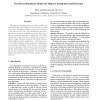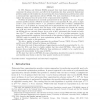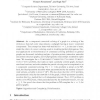1507 search results - page 102 / 302 » Separating Complexity Classes Using Structural Properties |
CVPR
2005
IEEE
15 years 2 days ago
2005
IEEE
We propose using simple mixture models to define a set of mid-level binary local features based on binary oriented edge input. The features capture natural local structures in the...
EMSOFT
2003
Springer
14 years 3 months ago
2003
Springer
Despite significant research on state-space reductions, the poor scalability of model checking for reasoning about behavioral models of large, complex systems remains the chief ob...
SIGECOM
2006
ACM
14 years 4 months ago
2006
ACM
Games may be represented in many different ways, and different representations of games affect the complexity of problems associated with games, such as finding a Nash equilib...
MST
2007
13 years 9 months ago
2007
In 1996, Khanna and Motwani [KM96] proposed three logic-based optimization problems constrained by planar structure, and offered the hypothesis that these putatively fundamental ...
COCOON
2007
Springer
14 years 4 months ago
2007
Springer
An r-component connected coloring of a graph is a coloring of the vertices so that each color class induces a subgraph having at most r connected components. The concept has been w...



